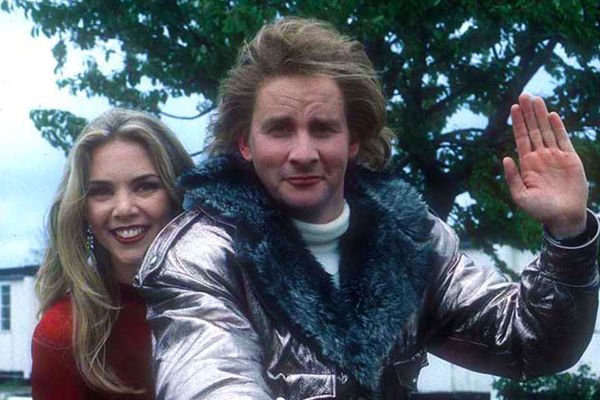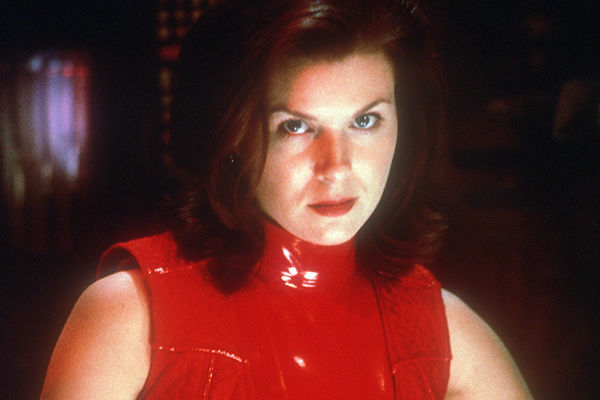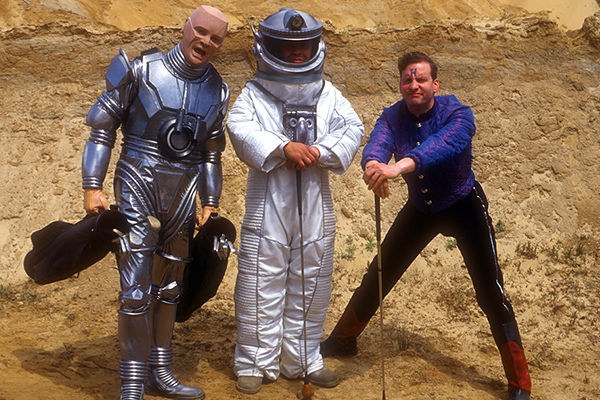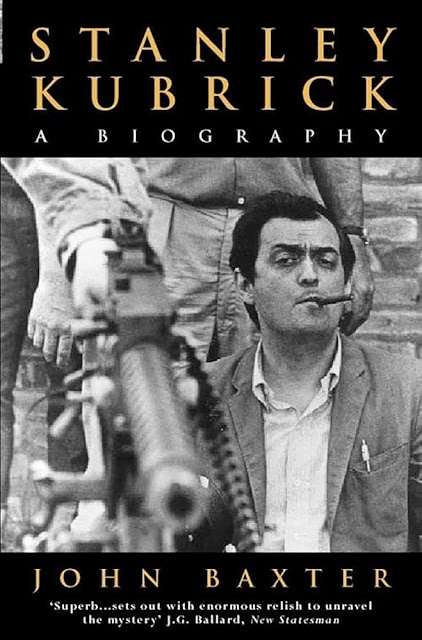Red Dwarf VII saw another minor revolution in the series history, and the greatest challenge to its continuing existence. Craig Charles, Danny John-Jules and Robert Llewellyn were all returning for the seventh season, but Chris Barrie decided that he didn't want to reprise his role as Rimmer, particularly as he was now busy starring in his own sitcom The Brittas Empire.
Eventually, Barrie was persuaded to appear in a few episodes of this season of Red Dwarf, to give his character a proper send-off, but after that the series would be losing one of its two principal stars. Red Dwarf VII would attempt to replace him by bringing back Lister's former love Kristine Kochanski as the fourth crew member.
Completely absent this time was
Red Dwarf's co-creator Rob Grant. Up to this point, each series had been written exclusively by its creators Rob Grant and Doug Naylor. With the absence of Grant,
Red Dwarf VII would see Doug Naylor take creative control and bring in additional co-writers, the most frequent being regular sitcom writer Paul Alexander. Kim Fuller, James Hendrie and cast member Robert Llewellyn also co-wrote some episodes. This series did see the return of director Ed Bye, who had been absent after
Red Dwarf IV, originally because he was working on his wife Ruby Wax's TV show.
The number of episodes this season was increased from the usual six to eight, with the expectation that after one more series there would be enough Red Dwarf instalments to meet the requirements for US syndication, and the episode lengths are slightly shorter, presumably to allow for advertising breaks when sold to commercial channels abroad.
 |
| What a guy! Princess Bonjella (Alison Senior) and Ace Rimmer (Chris Barrie) in "Stoke Me a Clipper" |
Red Dwarf VII rejected the traditional multiple camera TV sitcom set-up with a studio audience used in previous series, in favour of a single camera set-up with no audience. This allowed each shot in the series to be individually lit, as in a feature film.
The first few episodes signal the series' increased visual ambition, including a battle with Nazis, a medieval joust and a re-staging of the assassination of JFK. This series also has guest appearances from Brian Cox, Sarah Alexander and Don Henderson, the latter in one of his last screen roles.
The seventh season begins moderately well with "Tikka to Ride", in which Lister's desperate desire for a curry leads the crew to travel back in time, ending up in Dallas in 1963. There they accidentally save the life of President Kennedy ... with unexpectedly disastrous consequences.
"Stoke Me a Clipper" begins in riotous style as Ace Rimmer, Rimmer's alter ego from an alternative dimension, takes on the Nazis in an Indiana Jones type adventure that sees him rescuing a princess and escaping from an exploding plane on the back of an alligator (as you do).
Later, Ace appears on Red Dwarf, where he has a confession to make to the crew. He is just the latest in a long line of Ace Rimmers. Now that he is dying, he needs to pass the torch on. Could Red Dwarf's Rimmer take his place, giving up a lifetime of selfishness and cowardice to become the hero the universe needs?
Chris Barrie appears briefly in flashback in a couple more episodes after this, but otherwise he had now left the series' regular cast. And without him Red Dwarf begins to struggle. Using Barrie briefly in later episodes probably seemed like a good way of rationing out Rimmer's last appearance, but it does mean that the audience is continually reminded of him.
The whole of the sixth episode, "Blue", is even based on the notion that Lister is pining for him, leading to flashbacks, an alarming homoerotic dream sequence and a theme park ride in praise of Rimmer.
 |
| Kryten (Robert Llewellyn) and Cat (Danny John-Jules) in "Epideme" |
The series' third episode, "Ouroboros", sees Lister discovering his real parentage and the reasons why he was abandoned as a baby in a cardboard box in a bar. Baby Lister in these scenes is played by Alexander John-Jules, the nephew of Danny John-Jules.
More importantly for the series, this episode sees a corridor opened between two dimensions, allowing the Red Dwarf crew to meet their counterparts from an alternative dimension. These include Lister's long lost love Kochanski (now played by Chloë Annett), who is in a relationship with her own dimension's Lister. In a particularly contrived episode, Kochanski is separated from her crew and trapped with the other Dwarf boys, not once but twice, before finally being stranded with them in the wrong dimension.
Replacing Rimmer was always going to be a challenge, particularly for a series that began as essentially a two-hander. The writers decided to make it even harder on themselves by introducing a woman into the previously almost all-boys world of Red Dwarf.
This version of Kochanski is quite different from the one seen before, being much more uptight and upper middle class, with an English accent instead of the original's Scottish one. She does claim to have attended "the best public school in Glasgow", but her accent is pure Home Counties. The original version was not only Scottish, but more down to earth, someone you might imagine Lister having a beer with. This one is more like a snooty public schoolgirl who's arrived straight from the pony club.
It's very difficult to imagine this version of Kochanski ever having had any kind of relationship with Lister at all and it's not clear why the writers decided to make her Kochanski, when she has nothing in common with the character as previously established.
After the expansive first two episodes, the characters are largely stuck on board ship for the next few and reduced to crawling around the ventilation shafts in the fourth episode "Duct Soup". By this time, Kochanski is struggling to fit in, unable to adjust to the ship or the crew, or to being the only woman on board. This is despite her having previously been on a near-identical ship with a near-identical crew.
 |
| Kryten, Kochanski (Chloë Annett), Cat and Lister in "Duct Soup" |
The most interesting of the later episodes is probably "Beyond a Joke". This was co-written by Robert Llewellyn and, unsurprisingly, focuses on his character Kryten. The episode doesn't make a lot of sense (where did the crew suddenly get hold of a full body GELF suit disguise?) and adds a pointless bit of back story for Kryten. But it does give Llewellyn the opportunity to play an alternative version of his character, a similar mechanoid whose brain is addled from substance abuse.
It also features a detour into a VR game, Pride and Prejudice World, at Kochanski's insistence (because she's a girl, and girls like Jane Austen, right?). Here, Lister, Cat and Kochanski dress in 19th century clothes and meet up with Mrs Bennett and her twittering daughters from Jane Austen's novel - until Kryten gets impatient and gatecrashes in a tank borrowed from a war game. This tank was apparently the same one that was used in the James Bond film Goldeneye.
In "Epideme", Lister is infected with a sentient virus, the only cure for which is somewhat drastic - the removal of his infected right arm. In the final episode, "Nanarchy", the crew track down Kryten's nanobots, who have abandoned him and been voyaging around inside Lister's laundry basket (well, they are very small). The nanobots are recruited to recreate Lister's lost arm, but they also rebuild Red Dwarf itself.
Although it starts off well enough and has some decent episodes, the loss of Rimmer is keenly felt in Red Dwarf VII and Kochanski never had a hope of successfully replacing him. The decision to introduce a female character seems to have been made partly with the regularly mooted (but ultimately never made) Red Dwarf film in mind. But adding an attractive woman to the regular cast - especially one with a romantic back story with Lister - immediately upsets the delicate balance between the principals. Now the character dynamics of the crew, so long a crucial part of the series, no longer ring true.
Kochanski's complete lack of any sexual or romantic interest in Lister - despite the fact that he is literally the last man left in the universe and identical to her own Lister - also strains credibility. The effect of her arrival on poor Kryten is even worse, with Llewellyn's character reduced to childish jealousy, convinced that Kochanski has replaced him in Lister's affections.
 |
| Chloë Annett as the new Kochanski |
A more fundamental problem with the new version of Kochanski is that she is simply not a comedy character. She is an obvious "Mary Sue", someone parachuted in to save the day and show the boys how everything should be done. She has no flaws to speak of - beyond being too cultured, too clever and too damn perfect.
Its makers have described Red Dwarf VII as more of a comedy-drama than a sitcom and that's partly true. But to make a successful comedy-drama you do need to have interesting and sympathetic characters. Unfortunately, Red Dwarf VII replaces Rimmer with the non-character of Kochanski, and turns Lister into a lovelorn chump and Kryten into a whiny irritant.
An additional issue in this series is that the first episode, "Tikka to Ride", establishes that the crew can now somehow travel in space and time, destroying the premise that Lister is stuck in deep space as the only human left alive. This does raise the question of why the crew don't now just return to Earth, just as Lister always wanted.
Red Dwarf VIII would arrive two years after this in 1999 and would see the unexpected return of Chris Barrie as Rimmer. The eighth series would be Red Dwarf's last on the BBC, and would see it undergo another significant change of format.







Comments
Post a Comment